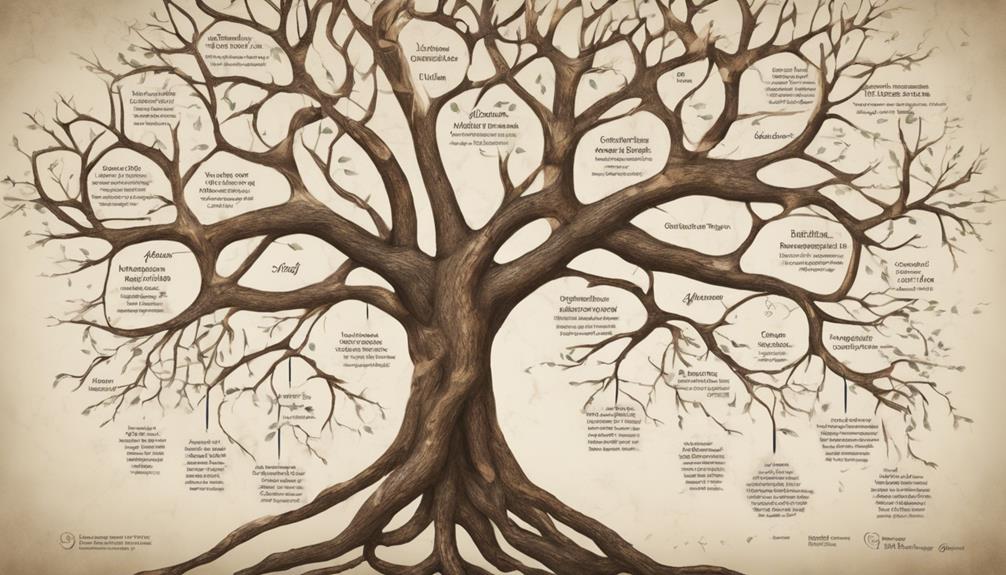Yes, Lewy Body Dementia can be passed down through specific gene mutations such as SNCA, SNCB, GBA, and APOE. These genetic mutations impact the risk factors and patterns of inheritance for the disease. Mutations in genes like SNCA and SNCB typically follow a dominant inheritance pattern, increasing the likelihood of developing the disease. A family history of related conditions like Parkinson’s disease can also elevate the risk. It is crucial to understand the genetic factors involved in order to identify hereditary connections. These genetic elements play a crucial role in determining the chances of developing Lewy Body Dementia. Further information on genetic predisposition and risk factors can be found in research materials.
Key Takeaways
- Mutations in genes SNCA, SNCB, GBA, and APOE increase hereditary risk.
- SNCA and SNCB mutations follow an autosomal dominant inheritance pattern.
- Family history of related conditions impacts susceptibility.
- Understanding genetic factors aids in risk assessment.
- Genetic counseling helps in comprehending hereditary components.
Genetic Factors in Lewy Body Dementia
Genetic mutations in specific genes play an important role in the development of Lewy body dementia. Mutations in genes such as SNCA, SNCB, GBA, and APOE can increase the risk of developing this condition.
SNCA and SNCB gene mutations follow an essential inheritance pattern, meaning that inheriting a mutated copy from just one parent can impact disease development. These mutations lead to the formation of Lewy bodies, which are abnormal protein deposits in the brain.
Individuals with a family history of Lewy body dementia or Parkinson's disease are at a higher risk of inheriting genetic factors linked to the condition. Understanding the genetic architecture of Lewy body dementia is vital as it can help identify hereditary components and potential risk factors for the disease.
Family History and Disease Risk

When considering family history and disease risk in Lewy Body Dementia, it's vital to comprehend the genetic predisposition factors that can impact an individual's likelihood of developing the condition.
Family genetics play a significant role in determining the inherited risk of Lewy Body Dementia, particularly when there's a history of the disease or related conditions like Parkinson's disease.
Genetic Predisposition Factors
Having a family history of Lewy body dementia or Parkinson's disease can elevate an individual's risk of developing Lewy body dementia. Genetic predisposition factors play a vital role in determining this risk, with mutations in genes like SNCA, SNCB, GBA, and APOE increasing susceptibility. Inheritance patterns for these genes often follow an autosomal dominant pattern, especially with SNCA and SNCB mutations contributing to familial cases of Lewy body dementia. Understanding these genetic factors is essential as it helps identify individuals at higher risk and guides the implementation of preventive measures or early interventions. Below is a table summarizing some of the key genes associated with genetic predisposition to Lewy body dementia:
| Gene | Inheritance Pattern | Contribution to Risk |
|---|---|---|
| SNCA | Autosomal Dominant | High |
| SNCB | Autosomal Dominant | Significant |
| GBA | Autosomal Dominant | Moderate |
Impact of Family Genetics
Understanding the impact of family genetics on Lewy body dementia risk is essential for early intervention and preventive measures. Family history plays a pivotal role in evaluating the risk factors associated with Lewy body dementia. Having a relative with Parkinson's disease or a history of Lewy body dementia can increase one's susceptibility to the condition.
Specific gene mutations like SNCA, SNCB, GBA, or APOE are linked to the hereditary component of Lewy body dementia. Inheritance patterns may follow an autosomal dominant pattern, where inheriting one mutated gene copy increases the risk. Genetic counseling is recommended for individuals with affected family members to comprehend their risk factors and consider preventive strategies.
Recognizing the influence of genetic factors is crucial for a thorough disease risk assessment.
Understanding Inherited Risk
Genetic mutations in genes like SNCA, SNCB, GBA, and APOE can significantly increase the risk of developing Lewy Body Dementia, highlighting the importance of understanding inherited risk factors. Mutations in SNCA and SNCB are inherited dominantly, contributing to familial cases. Similarly, GBA gene mutations and specific APOE versions elevate the risk.
A family history of Lewy Body Dementia or Parkinson's disease can also raise susceptibility. Recognizing these genetic factors aids in identifying individuals at higher risk due to inherited mutations and family history. By comprehending these connections, individuals and families can take proactive measures and seek appropriate support and medical guidance.
Understanding inherited risk factors is essential for managing and potentially preventing the development of Lewy Body Dementia in susceptible individuals.
Hereditary Links to Parkinsons Disease

Mutations in genes like SNCA and SNCB can lead to a hereditary link between Parkinson's disease and Lewy body dementia. Individuals with a family history of Parkinson's disease are at a higher risk of developing Lewy body dementia due to shared genetic factors. Specific gene variants such as GBA and APOE e4 allele mutations also play a role in the hereditary component of Lewy body dementia. The genetic similarities between Lewy body dementia and Parkinson's disease suggest a potential hereditary connection between these conditions. Understanding the genetic basis of Lewy body dementia can help identify individuals at a higher risk due to family history or specific gene mutations.
| Hereditary Links to Parkinson's Disease |
|---|
| Mutations in genes like SNCA and SNCB |
| Family history of Parkinson's disease increases risk |
| Gene variants such as GBA contribute to hereditary component |
Understanding Inherited Risk Factors

In evaluating the probability of developing Lewy body dementia, we must consider the impact of inherited risk factors. Understanding how mutations in specific genes can increase susceptibility to this condition is vital. Here are four key points to keep in memory:
- Mutations in genes such as SNCA and SNCB can lead to Lewy body dementia. These mutations are inherited in an autosomal dominant pattern, meaning that only one copy of the mutated gene is needed to increase the risk.
- Individuals with mutations in the GBA gene or a particular version of the APOE gene also have a higher likelihood of developing Lewy body dementia in an autosomal dominant manner.
- Having a family history of Lewy body dementia or Parkinson's disease can elevate the risk of developing the condition. It underscores the importance of understanding one's family medical history.
- Changes in specific genes result in the formation of Lewy bodies, which are clusters of alpha-synuclein protein in neurons. These alterations play a significant role in the development of Lewy body dementia, emphasizing the importance of inherited factors in this disease.
Role of Genetics in Disease Development

Exploring the influence of our genetic makeup on disease development sheds light on the intricate mechanisms underlying conditions like Lewy body dementia. In Lewy body dementia, genetics play a significant role in disease development. Mutations in genes such as SNCA and SNCB can lead to the manifestation of this condition. Additionally, specific genetic changes in GBA or APOE variants can also contribute to an increased risk of developing Lewy body dementia. These genetic alterations prompt the formation of Lewy bodies, which are abnormal protein deposits found in the brains of individuals affected by this disease. Understanding the genetic basis of Lewy body dementia provides valuable insights into inheritance patterns and potential risk factors associated with the condition. Below is a table summarizing key genetic factors linked to Lewy body dementia:
| Genetic Factors | Role in Disease Development |
|---|---|
| SNCA and SNCB genes | Mutations can cause Lewy body dementia |
| GBA and APOE variants | Genetic changes elevate disease risk |
| Lewy bodies | Abnormal protein deposits in the brain |
Genetic Counseling for Dementia Prevention

Genetic counseling plays a vital role in evaluating our risk of inheriting Lewy body dementia.
By analyzing our family health history and identifying specific gene mutations, we can gain valuable insights into our susceptibility to this condition.
Understanding these genetic factors empowers us to make informed choices for dementia prevention and personalized healthcare decisions.
Genetic Risk Assessment
Understanding our genetic risk for hereditary Lewy Body Dementia involves identifying specific gene mutations associated with an increased likelihood of developing the condition. Genetic risk assessment and counseling play an essential role in determining the potential genetic predisposition to Lewy Body Dementia.
Here are four vital points to contemplate:
- Specific gene mutations in SNCA, SNCB, GBA, and APOE can greatly raise the risk of developing Lewy Body Dementia.
- Mutations in SNCA, SNCB, GBA, and the APOE e4 allele follow an autosomal dominant inheritance pattern, impacting the likelihood of hereditary transmission.
- Individuals with a family history of Lewy Body Dementia or Parkinson's disease may have a higher genetic predisposition to the condition.
- Early genetic screening and counseling can offer valuable insights into the hereditary factors influencing the risk of developing Lewy Body Dementia.
Family Health History
Our discussion on genetic risk assessment for Lewy Body Dementia naturally leads us to ponder the significance of family health history in understanding and addressing hereditary factors.
Family health history provides valuable insights into the potential hereditary risk of developing Lewy body dementia. Genetic counseling can assist individuals in comprehending their risk factors based on this history.
Inheritance patterns of this condition can follow an essential dominant pattern, indicating a higher chance of passing on the disease. Specific mutations in genes like SNCA, SNCB, GBA, and APOE can elevate the risk of hereditary Lewy body dementia.
Understanding these genetic factors and inheritance patterns is vital as it can help guide preventive measures and early detection strategies for individuals at risk.
Implications for Future Generations

In considering the future impact of Lewy body dementia within families, it's essential to acknowledge the potential genetic predisposition that can be passed on to subsequent generations. Understanding the hereditary component of this condition can help families prepare for potential risks and take proactive steps towards early detection and intervention strategies. Here are some important implications for future generations: Families should be aware that while Lewy body dementia is not strictly hereditary, there may still be a lewy body dementia family risk due to shared genetic and environmental factors. This awareness can encourage individuals with a family history of the disease to remain vigilant about early symptoms and seek medical advice when necessary. By fostering open communication and supporting research into the genetic aspects of the condition, future generations may benefit from more effective preventative measures and treatments.
- Genetic Mutations: Mutations in genes like SNCA, SNCB, GBA, or APOE can increase the risk of developing Lewy body dementia and may be passed down to children.
- Inheritance Pattern: SNCA and SNCB mutations follow an autosomal dominant inheritance, meaning a child of an affected parent has a 50% chance of inheriting the mutation.
- Increased Risk: Carrying GBA gene mutations or APOE e4 allele variants can elevate the risk of developing Lewy body dementia, potentially affecting future generations.
- Family History Impact: A family history of Lewy body dementia or Parkinson's disease can raise the risk for future generations, emphasizing the importance of genetic counseling and early detection strategies.
Frequently Asked Questions
What Are the Early Signs of Lewy Body Dementia?
Early signs of Lewy Body Dementia include visual hallucinations, mood swings, cognitive issues like memory loss, and parkinsonism symptoms. REM sleep behavior disorder and impaired visual-spatial tasks may also manifest early in individuals with this condition.
Who Is at High Risk for Lewy Body Dementia?
We are individuals with certain genetic mutations like SNCA, SNCB, GBA, or APOE who face a higher risk of developing Lewy body dementia. Family history of the disease or Parkinson's also increases susceptibility.Genetic predisposition greatly influences our likelihood of developing Lewy body dementia.
What Are the Red Flags for Lewy Body Dementia?
Identifying red flags for Lewy Body Dementia is essential. Signs like visual hallucinations, movement issues, and cognitive fluctuations are key. Early detection of behavioral changes, speech difficulties, and REM sleep behavior disorder can aid in timely diagnosis and treatment.
Will I Get Lewy Body Dementia if My Mom Has It?
If my mom has Lewy Body Dementia, our risk may increase due to genetic factors, but it doesn't guarantee I'll get it. Understanding family history and potential risk factors is essential. Lifestyle and environmental choices also play a role.
Conclusion
So, is Lewy Body Dementia hereditary?
While there's a genetic component to the disease, it isn't solely determined by genes. Family history and other factors play a role in the risk of developing the condition. Understanding inherited risk factors and seeking genetic counseling can help in prevention.
Remember, genetic factors are just one piece of the puzzle when it comes to Lewy Body Dementia.
Can we take steps to reduce our risk?








